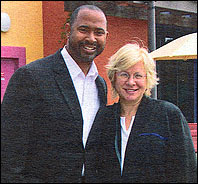



March 13, 2006
Diamond's Emergence a Boon to Neighborhood
San Diego Business Journal
By Mike Allen
The Jacobs Center for Neighborhood Innovation is a non-profit foundation that operates on the premise that residents must own and drive the change that takes place in their community for it to be meaningful and long-lasting. JCNI explores new pathways to change through entrepreneurial relationships, hands-on training, and the creative investment of resources.
Diamond's Emergence a Boon to Neighborhood
San Diego Business Journal
By Mike Allen
 |
MIKE ALLEN
San Diego City Councilman Tony Young, Who represents the Diamond area, and Jennifer Vanica, CEO of the Jacobs Center for Neighborhood Innovation. |
Redevelopment: Public Offering May Be a First In Nation; Residents Are Buying in- Literally
The area in southeast San Diego known as Diamond, centered on Euclid Avenue and Market Street, had a reputation as one of the most violent in the city.
“It was a pretty tough neighborhood,” said longtime resident Rickey Laster. “They called the four corners out at Euclid and Imperial (a bit farther west) ‘the four corners of death.’”
Yet on a recent Friday afternoon, the only dangerous activity at the Market Creek Plaza, a brightly painted shopping center finished last year, was getting in and out of parking stalls. Traffic was brisk, especially at Food 4 Less supermarket, the anchor store that opened in 2001, and among the highest-grossing units in the chain.
To be sure, gangs haven’t completely abandoned the area, but all regard the shopping center as neutral territory, said Jennifer Vanica, president and CEO for the Jacobs Center for Neighborhood Innovation.
The nonprofit, largely funded by the Jacobs family (not related to Qualcomm Inc. founder Irwin Jacobs), purchased 10 acres formerly occupied by an out-of-business aerospace manufacturer in 1998. Then the organization began asking residents what they would like to see in its place.
During the last eight years. Residents met and held workshops, figuring out what kinds of stores and shops at the center, the colors of the paint, and the kind of artwork it would feature.
The process of inclusion didn’t stop at designing the center and getting local contractors build it. To get residents to feel this shopping center really is theirs. Jacobs floated an even more radical concept: spinning off 20 percent of ownership of the center by selling shares in a new entity know as Market Creek Partners LLC.
At the same time, another 20 percent stake is being sold to a smaller group of investors called the Neighborhood Unity Foundation.
Completely Independent
Within 10 years, Jacobs intends to sell its 60 percent ownership to both groups.
“This is an exciting new tool for the field of community development. We believe this is the first of its kind in the nation, and we are being watched by a lot of other places who are considering doing the same thing,” Vanica said.
Angela Glover Blackwell, CEO for PolicyLink, an Oakland-based research firm focused on community revitalization, said she’s worked in community redevelopment for about 25 years but has never heard of anything resembling what’s taking place at Market Creek Plaza.
“This moves residents from being stakeholders to stockholders in the development of their community, she said.
Under the required prospectus filed and recently approved by the California Department of Corporations, Market Creek Partners is selling 50,000 shares or units in the limited liability company at $10 per unit.
Buyers, all of whom must live, work or own a business within the Diamond area, must purchase a minimum of 20 units, or $2100. The area encompasses the neighborhoods of Chollas View, Emerald Hills, Encanto, Lincoln Park, Mountain View, Mount Hope, Oak Park, Valencia Park and Webster.
Local Impetus
The desire to become equity owners the project came from residents, not the Jacobs Foundation, Vanica said. After Joe Jacobs, the late founder of Jacobs Engineering, gave a speech about the time the project’s beginning, residents wanted to know how they could invest in it. The foundation had been looking at a private placement, but because the interest in buying equity in the project was so deep, it realized fairly quickly that mechanism wouldn’t be adequate, Vanica said.
The process of structuring what constitutes an initial public offering based on a community development took about four years to complete. Not only had nothing similar ever been done, to allow residents to understand the concept of investing and all the potential risks, complex legal documents describing the public offering had to be rewritten and translated to Spanish.
Bevelyn Bravo, a resident who lives near the shopping center and is part of its design team, wasn’t aware of the concept of investing for profit before getting involved in the project, but said she does now, and plans to plunk down the minimum $200 when units go on sale this month.
There are Risks
Laster, whose business, Multi-Cultural Contractors Group, helped construct the center, also plans to buy units.
The Market Creek Partners prospectus, titled, “Own a Piece of the Block,” outlines all sorts of negative scenarios, including the lack of liquidity because of a limited number of investors and lack of a public market, and the fact that the enterprise is still financially dependent on the Jacobs Center for Neighborhood Innovation.
While fully disclosing the worst scenarios, the prospectus also provides ample evidence that an investment into the project is likely going to yield profits. The center turned about $200,000 in profits last year, and the rent alone paid by the Food 4 Less covers the annual debt payment on the Jacobs Center’s $15 million loan, Vanica said.
####
The Jacobs Center for Neighborhood Innovation is a non-profit foundation that operates on the premise that residents must own and drive the change that takes place in their community for it to be meaningful and long-lasting. JCNI explores new pathways to change through entrepreneurial relationships, hands-on training, and the creative investment of resources.
 |
 |